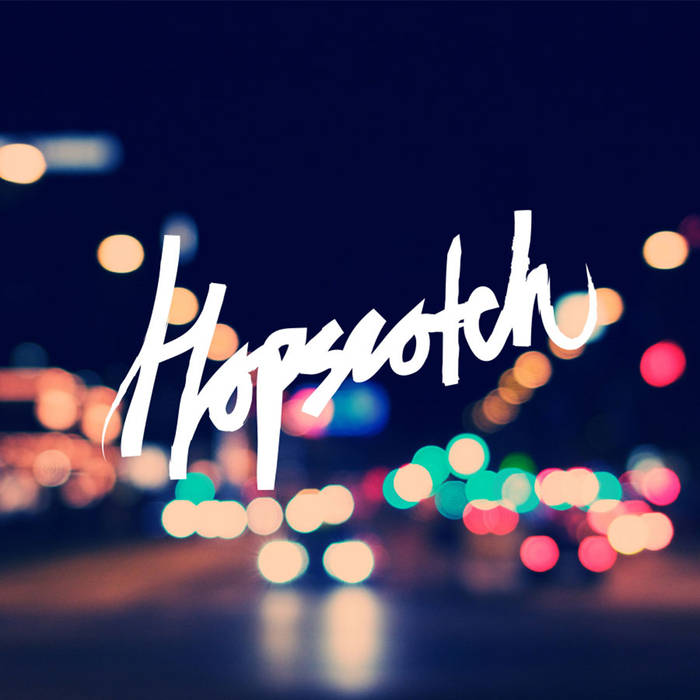-
Chapter 2 CrashRed Route - An intersection in Boyle Heights
Lucha and Jamson exchange information in the aftermath of their accident.
-
Chapter 4 Lucha's Quinceañera SongRed Route - Mariachi Plaza, Boyle Heights
Lucha remembers the day she left her childhood behind.
-
Chapter 6 Jameson PortraitYellow Route - The 2nd Street Tunnel, Downtown Los Angeles
Jameson contemplates the multifaceted nature of his personality.
-
Chapter 7 The ReunionYellow Route - A Rehearsal Studio in the Arts District
Lucha and Jameson connect at Lucha's performance of Orpheus and Eurydice.
-
Chapter 8 First KissRed Route - Hollenbeck Park, East Los Angeles
Romance blooms on Lucha and Jameson's first date.
-
Chapter 9 Angel's PointGreen Route - Angel's Point, Elysian Park
Lucha and Jameson share a passionate physical experience.
-
Chapter 11 The Floating NebulaGreen Route - The Corn Fields, Los Angeles State Historic Park, Chinatown
The metaphysical peak in Lucha and Jameson's love.
-
Chapter 12 WeddingYellow Route - City Hall, Downtown Los Angeles
On their wedding day, Lucha gives Jameson a fateful gift.
-
Chapter 14 The Phone Call, Part 1Red Route - Traversing between the Arts District and Boyle Heights
Lucha receives a mysterious phone call from a voice she seems to recognize.
-
Chapter 17 Orlando's FairwellRed Route - Evergreen Cemetery
Before leaving Los Angeles, Orlando pays his last respects to his wife.
-
Chapter 18 Interlude (Car Wash)Green Route - AirStream Trailer, Elysian Park
Reflect on the impact of a location's geography on a person's psyche.
-
Chapter 24 The Red NotebookRed Route - Utter darkness
In a state of darkness, Lucha is haunted by Jameson's red notebook.
-
Chapter 25 The Other WomanYellow Route - The Bradbury Building, Downtown Los Angeles
Still submerged in darkness, Lucha dreams of Jameson's infidelity.
-
Chapter 26 HadesGreen Route - Bowtie Parcel, Los Angeles River
Lucha descends to the underworld in search of Jameson.
-
Chapter 28 Lucha and Orlando in LoveYellow Route - Historic Core, Downtown Los Angeles
After years apart, Lucha and Orlando reunite in Los Angeles.
-
Chapter 33 Farewell From the Roof TopsRed Route - Rooftops, Toy Factory Lofts, Biscuit Lofts, Ito Building Tower, Arts District
Lucha makes peace with Jameson's disappearance.

First Kiss
Jameson: Victor Mazzone
Roller skater: Stephanie Williams
Saxophone: Logan Hone
Tuba: Stefan Kac
Cajón: Linnea Sablosky
Accordion: Isaac Schankler
Percussionist: TJ Troy
Music by Marc Lowenstein
Text by Erin Young
Director’s Notes:
“This chapter shows Lucha and Jameson starting to fall in love. They take a winding path through Hollenbeck Park and look over the lake.
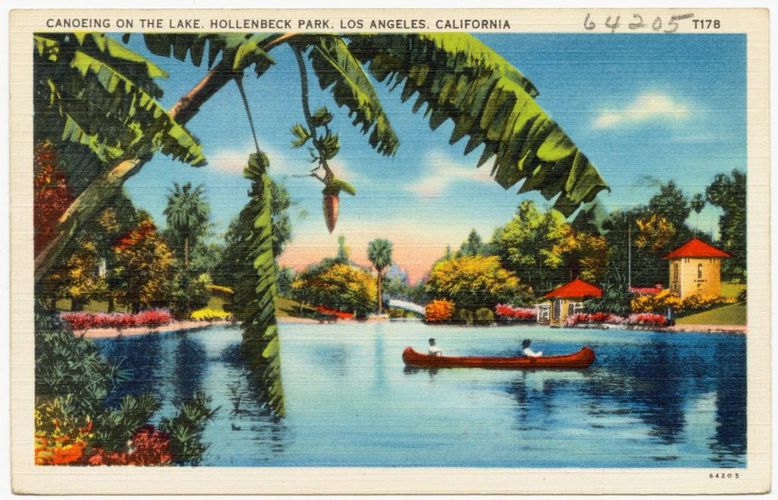
Hollenbeck Park
In the 1950s when authorities plotted the Golden State Freeway, they planned for it to jut right over the lake in this historic park. Locals saw it as an arrogant attack on their neighborhood, and many still claim that the neighborhood has never been the same since.
As they’re walking, musicians all over the park suddenly seem to be playing in harmony.
“Lucha and Jameson’s internal monologues open up into irresistible love songs before they share their first kiss.
Even a roller skater starts to sing along.
Jameson and Lucha in the Park
Excerpt from the Hopscotch album, Track 5. Composer, Marc Lowenstein
“The major inspiration for this scene – which dictated the direction of Marc’s dance-like music and Ann’s colorful, fantastical costumes – came from the movie adaptation of Pajama Game, which was shot in that park 60 years ago. The characters in the movie fall in love, proclaiming it a ‘Once a Year Day,’ and suddenly everyone in the park seems to be dancing and singing. In Los Angeles, real history and the fictional history of cinema constantly overlap with each other; part of the psychogeographic mission of Hopscotch was offering audiences another performative fiction that interacted with both histories in an indeterminate way.
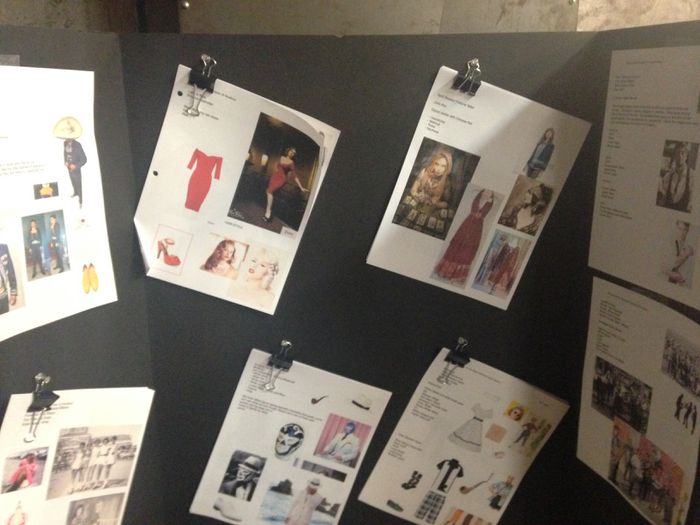
“We chose the colors specifically for each character. Lucha would be yellow as the sun, joy…it’s a color that holds is self present all day… Orlando is brown, of the earth. Jameson is black and white as if it is a distant, noir character… We have our musicians in blue, which are of the sky, and of the things that are very California,” says Hopscotch costume designer Ann Closs-Farley, as she displays her inspiration board at the first rehearsal of Hopscotch.
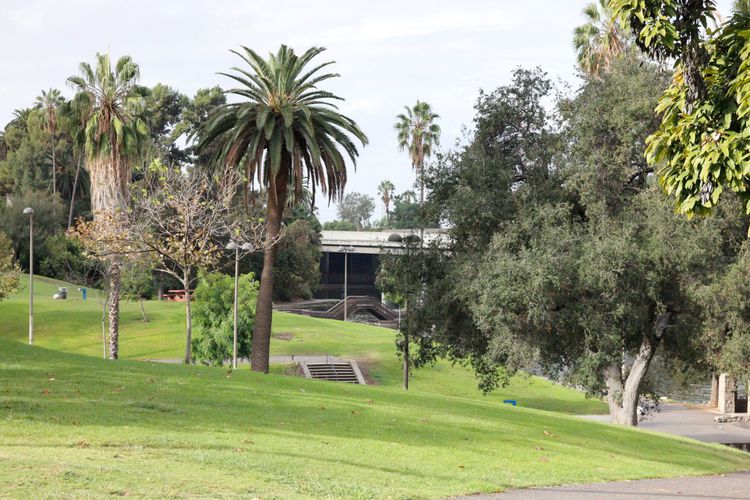
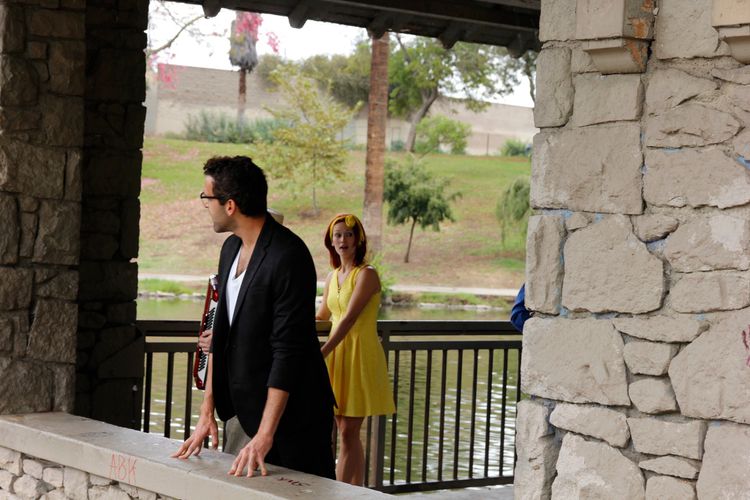
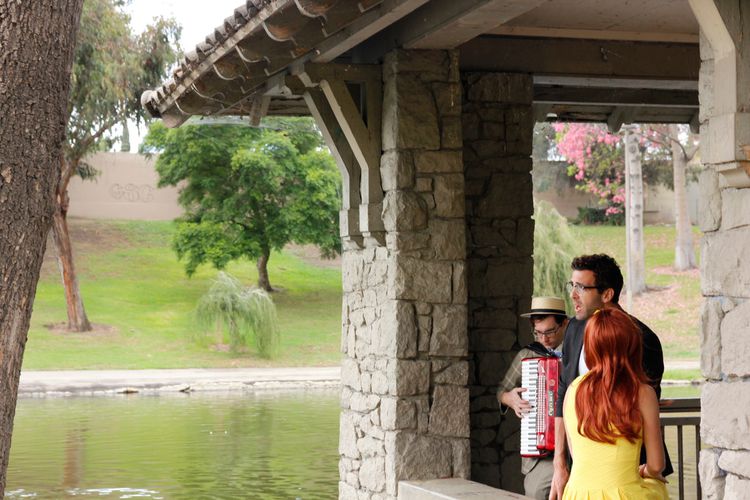
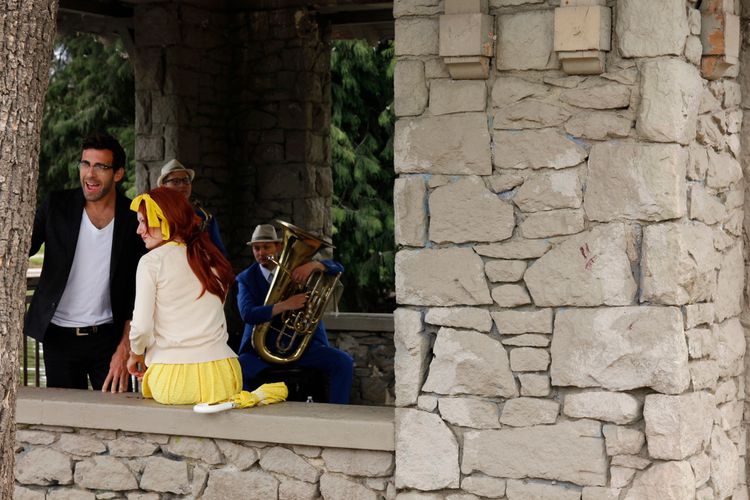
“One of the sad ironies of Hopscotch was that it was this chapter of blossoming young love that raised the ire of a small but aggressive anti-gentrification faction in the neighborhood. Although we were warmly welcomed in all the communities that Hopscotch visited, including many of the residents, businesses, and arts groups of Boyle Heights, this antagonistic group was vocal in their hostility towards the singers and musicians and disrupted the final performance.
Stephanie Williams speaks about the impact of her surroundings on her performance
“Most of us who created or performed in Hopscotch devoted ourselves to art because of our faith in its constructive social power and its ability to celebrate and inspire togetherness – so it saddened all of us to be confronted with a perception of our work as alienating and threatening. That our communal vision of a diverse, multitudinous, and open city could still be misconstrued, even after a year-long process of dialogue and outreach, reminded all of us what it meant to be doing work in unrestricted public places, where everyday life and art intermingle. Every if other chapter may have offered audiences and passersby a powerful example of art’s ability to transform our view of the streets, this experience in Hollenbeck Park showed us all how much work there is yet to do in our very own city.”

